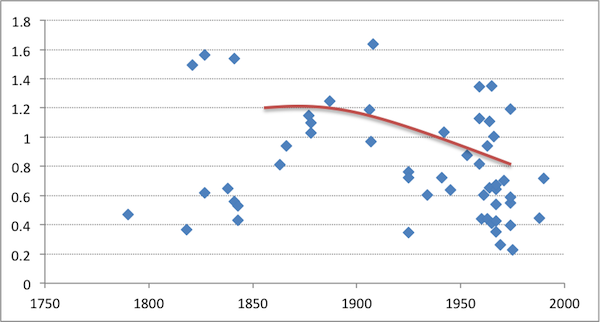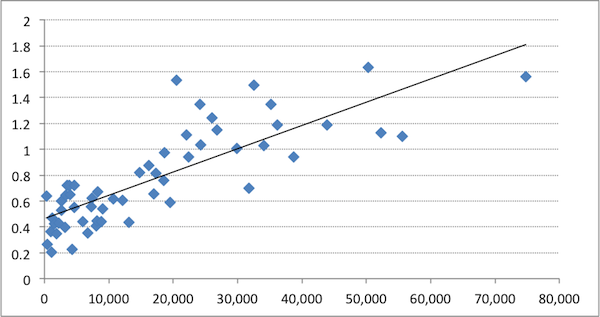Today, we use our H-index Benchmarking of Academic Research (HiBAR) to look at the relationship between institutional characteristics and H-index scores.
We’ve talked a lot this week about the positive correlation between a researcher’s age and his or her H-index score. But there’s another correlation to watch for: normalized institutional average H-index scores and institutional age. Check it out:
Normalized Institutional Average H-Index Score as a Function of Institutional Age

The result isn’t wholly clear cut: there are a lot of institutions that were created in the 50s and 60s which have surprisingly good normalized H-index scores, and a clutch of small liberal arts schools which have very low averages despite being quite old. However, overall, the relationship between age and normalized H-index score is negative.
This is interesting because it helps to demonstrate the degree to which institutional prestige – which is generally correlated with institutional age – has do with where talented academics try to locate. Academic salaries aren’t that different across the country; if academics only looked at money, one would expect a much smaller relationship between institutional age and average normalized H-index values. Basically, top researchers want to be where other top researchers are; and older, more prestigious institutions are always going to have a head start as far as concentrations of talent are concerned. It’s a virtuous circle – and one that’s very hard for new institutions to crack.
Another relationship we’re looking at is institutional size and average normalized H-index score. To wit:
Normalized Institutional Average H-Index Score as a Function of Institutional AgeSize

This is a much more straightforward result: big institutions have a lot more faculty members with long publication records. That may seem obvious, but it wouldn’t be the relationship that would hold in, say, the United States, where a lot of top institutions (e.g., Harvard, Yale) are quite small. In Canada, where the ability to pay for big-time research is dependent upon having a lot of undergraduates generating income that can be skimmed, it’s a much more direct relationship.
Stunningly, not a single university with less than 20,000 students has an average normalized H-index score above one (i.e., above the national average for all academics). This has some pretty significant implications for schools like Victoria and Saskatchewan, which have some significant research strengths but can’t generate sufficient revenue from undergraduate enrolment to make a really big push into the top league.
Now, the keenest-eyed among you may be looking at those two charts and wondering about those y-axis values. Are those really full-institution H-index values, normalized across all disciplines? Couldn’t somebody do a really interesting and unusually reliable research ranking with those?
The answers are yes and yes. But patience, grasshoppers: we’re not ready to roll it out just yet. You can spend the summer looking forward to it as a back-to-school treat.

 Tweet this post
Tweet this post
